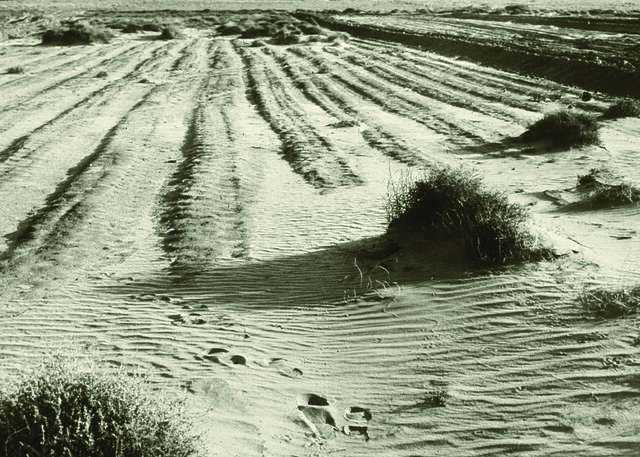
- Wind-devastated farmland in Kansas during the Dust Bowl.
The U.S. Southern Plains states have always been known for their wild weather. Stories of the volatile climate of this region abound. Whether you’re talking about Pecos Bill roping a tornado in Texas, Dorothy being blown away by a twister to the Land of Oz, or the Dust Bowl in Oklahoma where “the wind comes sweeping down the plains,” all three of the Southern Plains states have a well-deserved reputation for extreme weather events. Never has this been more on display than in 2015. At the beginning of this year, the states of Kansas, Oklahoma, and Texas had suffered through four long years of an extreme drought greater even than those that ravaged the region during the Dust Bowl of the 1930’s. This extreme weather cost agriculture in the region well over $20 billion and put an incredible strain on the available water supplies of numerous communities. Then, in what seemed like the blink of an eye, in a repeat of what has happened so many times in the past, the extreme drought on the Southern Plains was finally broken by extreme rainfall.
May 2015 now ranks as the wettest month EVER in the history of Texas and Oklahoma. In Texas, the statewide average rainfall for May 2015 was 8.81 inches, shattering the old record of 6.66 inches. In Oklahoma, over 14.40 inches of rain fell in the same month, obliterating the old record of 10.75 inches. Kansas also saw heavy rain events, and while these storms did not set the over-all record in the Sunflower State, many Kansas communities rainfall totals for the month of May that were higher than anything they had recorded in over 100 years.
Extreme weather is nothing new on the Southern Plains. We have seen droughts and floods before. What is new is the level of intensity and volatility of these events and what’s really interesting is that this increase in extreme weather is playing right to script for what the experts say the effects of climate change will be in the region. When you talk about the effects of climate change in the Southern Plains you basically mean that the region’s crazy weather will just get crazier and with that increase in volatility and severity, the area’s agriculture industry and its rural communities will face an ever increasing set of challenges. The good news is that USDA, through its various agencies and partners, have several programs and initiatives to help agriculture producers and our rural areas adapt to the effects of climate change while also helping to address some of the phenomenon’s root causes. As part of our work on this overall effort, we at the USDA Southern Plains Climate Hub have worked to identify these programs and highlight their benefits in our region while identifying ways to build on their successes. We have helped facilitate research both through traditional USDA channels and through other agencies venues such as the Environmental Protection Agency National Risk Management Research Laboratory, to help identify the multiple environmental benefits USDA natural resource programs provide, including climate change mitigation and adaptation. We have worked together with our sister USDA agencies to facilitate demonstration farms both in partnership with cooperating farmers and ranchers on privately owned land and on traditional research farm settings, to help identify and highlight adaptation and mitigation strategies that fit the unique geographical, cultural and economic challenges of the various ecoregions of the Southern Plains while at the same time making bottom line, economic sense for the regions agriculture producers.
Numerous other USDA programs also continue to help address climate change and its effects on Rural America. Programs like those that provide farmers and ranchers protection through the Risk Management Agency (RMA); initiatives designed to save energy, reduce emissions and support rural infrastructure at Rural Development (RD); the research and development of new and improved farming and ranching practices by the Agricultural Research Service (ARS) and the National Institute of Food and Agriculture (NIFA) funded projects designed to help agriculture adapt to and mitigate the effects of climate change all have a role to play in helping our entire nation (not just rural areas) address the numerous natural resource challenges we will face in the future. The USDA Southern Plains Climate Hub will continue to work with all of these critical players throughout the Department of Agriculture to facilitate their good work, identify ways we can improve on existing USDA efforts, and help ensure that our farmers, ranchers and rural communities have the tools they need to address the challenge created by our changing climate.
We have to understand that the future will be more challenging for all of us as we struggle to deal with the effects climate change. The good news is that today USDA already has numerous tools at its disposal to help our nation adapt to these challenging times while at the same time reducing our impact on the climate as we move forward.
